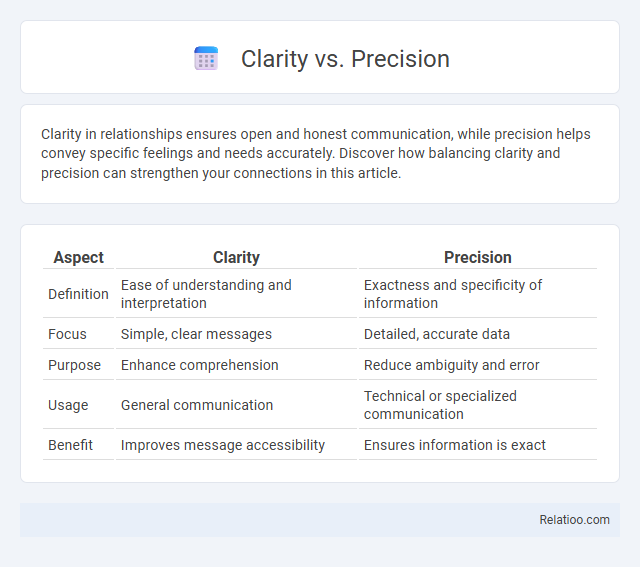Clarity in relationships ensures open and honest communication, while precision helps convey specific feelings and needs accurately. Discover how balancing clarity and precision can strengthen your connections in this article.
Table of Comparison
| Aspect | Clarity | Precision |
|---|---|---|
| Definition | Ease of understanding and interpretation | Exactness and specificity of information |
| Focus | Simple, clear messages | Detailed, accurate data |
| Purpose | Enhance comprehension | Reduce ambiguity and error |
| Usage | General communication | Technical or specialized communication |
| Benefit | Improves message accessibility | Ensures information is exact |
Introduction to Clarity vs Precision
Clarity ensures that information is easily understood, while precision focuses on the exactness and accuracy of the details presented. Effective communication relies on balancing clarity and precision to convey messages without ambiguity or vagueness. Mastering the distinction between clarity and precision enhances the quality of written and verbal expression, enabling more impactful and reliable information delivery.
Defining Clarity in Communication
Clarity in communication ensures your message is easily understood by eliminating ambiguity and using straightforward language. It focuses on delivering ideas in a simple, concise manner so the audience quickly grasps the intended meaning. While precision targets accuracy and detail, clarity prioritizes overall comprehensibility and effective information transfer.
Understanding Precision in Context
Precision in context refers to the exactness and specificity of information, ensuring details are clear and unambiguous for accurate interpretation. Clarity emphasizes the overall comprehensibility of a message, making it easy to grasp without confusion. Balancing clarity and precision enhances understanding by providing detailed yet easily interpretable content tailored to the audience's needs.
Key Differences Between Clarity and Precision
Clarity ensures your message is easily understood without ambiguity, while precision focuses on the exactness and accuracy of the information presented. Clarity simplifies complex ideas for broader comprehension, whereas precision demands detailed and specific data to avoid misunderstandings. Your communication benefits most when both clarity and precision are balanced, delivering information that is both accessible and exact.
When to Prioritize Clarity
Prioritize clarity when communicating complex ideas to diverse audiences, ensuring the message is easily understood without ambiguity. Clarity takes precedence in instructional content, customer support, and marketing materials where comprehension directly impacts effectiveness. Precise details can be introduced later, but initial clarity establishes a strong foundation for engagement and trust.
When Precision Matters Most
Precision matters most when accuracy directly impacts outcomes, such as in scientific research or legal documentation. Clarity ensures your message is easily understood, but without precision, the details may lead to misinterpretation or errors. Balancing clarity and precision is essential, yet in critical decisions, prioritize exact measurements and specific data to maintain integrity and trust.
Common Misconceptions About Clarity and Precision
Common misconceptions about clarity and precision often confuse these concepts as interchangeable; however, clarity refers to the ease of understanding information, while precision denotes the exactness and specificity of data. Many mistakenly believe that increasing precision automatically improves clarity, but overly detailed information can reduce comprehension if not presented clearly. Effective communication requires balancing clarity with precision to ensure both accurate and easily understandable content.
Balancing Clarity and Precision in Writing
Balancing clarity and precision in writing ensures your message is both understandable and accurately detailed, enhancing communication effectiveness. Clear writing avoids ambiguity, while precision provides specific, relevant information tailored to your audience's needs. You can achieve this balance by choosing concise language that conveys exact meanings without overwhelming readers.
Real-World Examples of Clarity vs Precision
Clarity in communication ensures the message is easily understood, while precision provides specific and exact details, crucial in fields like medicine and engineering. For instance, a doctor stating "Take 2 pills daily" is clear, but specifying "Take 2 500mg aspirin tablets every 12 hours" adds precision essential for patient safety. In contrast, marketing might favor clarity to engage a broad audience, demonstrating how context dictates the balance between clarity and precision.
Conclusion: Finding the Right Balance
Balancing clarity and precision is essential for effective communication, as clarity ensures your message is easily understood, while precision provides exactness and detail. You should tailor the level of detail based on your audience's needs, avoiding excessive complexity that hinders comprehension or oversimplification that sacrifices accuracy. Striking the right balance maximizes both understanding and informativeness, enhancing overall communication quality.

Infographic: Clarity vs Precision
 relatioo.com
relatioo.com